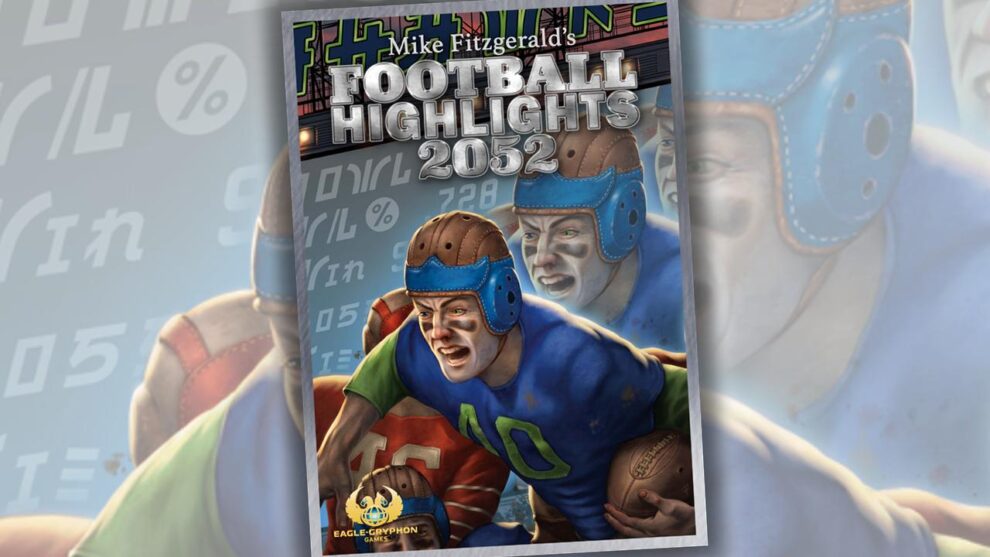Disclosure: Meeple Mountain received a free copy of this product in exchange for an honest, unbiased review. This review is not intended to be an endorsement.
Growing up, I spent a lot of weekends running around football fields with friends in the greater DC area. Whether it was flag, tackle, or touch, I was running post patterns or rushing the quarterback with other teenagers all the time. Driving the entire field in four plays to try and score was always a blast.
Decades later, I still love football, and my favorite activity with my son is chucking the football in our front walkway or at the big field around the corner. When I had the chance to review Football Highlights 2052—the next in the Highlights line of sports games designed by Mike Fitzgerald and published by Eagle-Gryphon Games—I took all that football knowledge and put the game to the test. (That also meant I had to step away from playing Tecmo Bowl on our Nintendo Classic Mini to write this review…which was not easy, friends.)
The game’s backstory is familiar, if you’ve tried any of the other Highlights games—by the late 2020s, football apparently became so unpopular that “football” (note that the NFL is not named but is clearly the governing body referenced here) began tinkering with Bio Mechanics, science that allowed alterations to protective gear as well as the addition of robots to the sport. By the early 2050s, football became popular once again, and in the board game, players manage a roster trying to score more points than their opponent.
Turning popular sports into interesting board games has certainly been a challenge, but Football Highlights 2052 does a better job than most because of its cardplay.
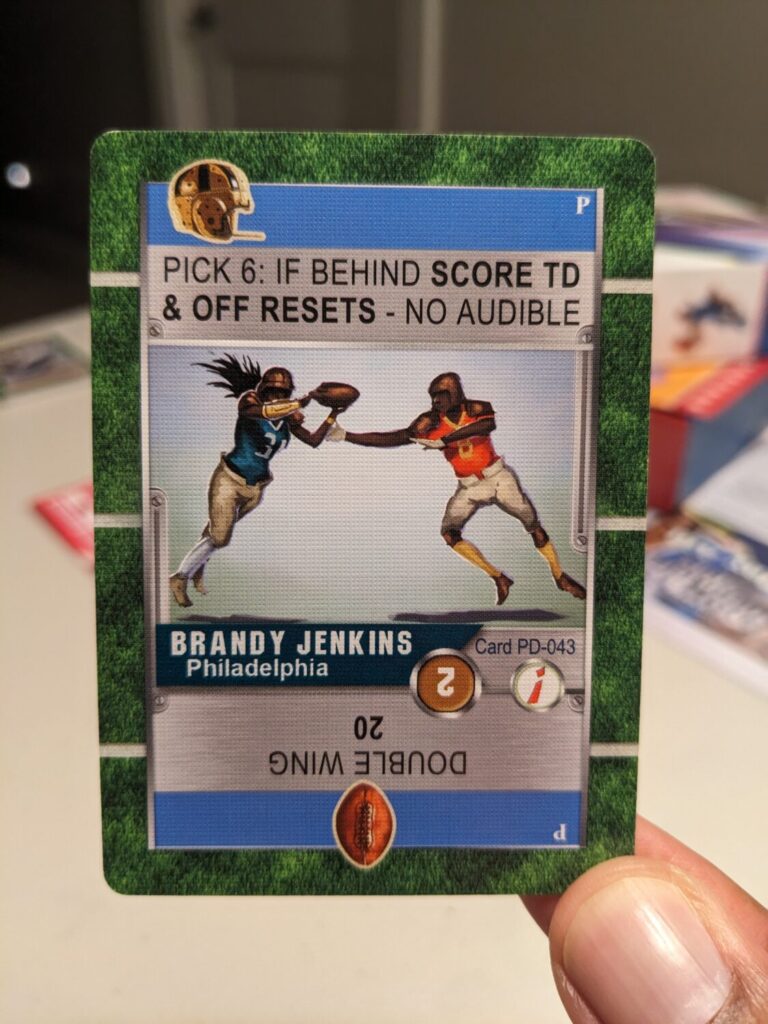
End Around
Football Highlights: 2052 is a 1-4 player (American) football simulator. It can be played solo, one-versus-one, or two-versus two in a team format. For this review, I played the game twice solo and once head-to-head against fellow Meeple Mountain contributor Joseph Buszek, a fellow football junkie who has experienced just as much NFL football heartbreak recently as I have…he’s a Lions fan, and I’m a Niners guy.
The main hook in Football Highlights: 2052 is tied to playing cards, where each card serves as both an offensive play AND a defensive play. Each player has their own player board representing their defensive side of the field. Boards are placed across from each other (in the two-player format), and each player has a football marker that is used to track progress moving downfield (towards the end zone of their opponent). That means that in my two-player game, my red football marker was on Joseph’s board, and when my team gained positive yards, Joseph would move my marker closer to his end zone.
Each player begins with a team of 15 cards: five “stars” and 10 normal defensive players, if using one of the pre-built teams included in the box. Players can alternatively choose to draft players upfront, using a separate deck.
Then, in a fun twist that brought me back to my time growing up, Football Highlights: 2052 gives players four offensive plays to drive 50 yards to score a touchdown. At any point after the end of one of those four plays, players can instead choose to kick a field goal. No 10-yard measurements are needed, and the field is broken down into five-yard spaces. In each half, each player will execute 10 offensive plays, so a player will usually have about two, maybe three drives to try to score points.
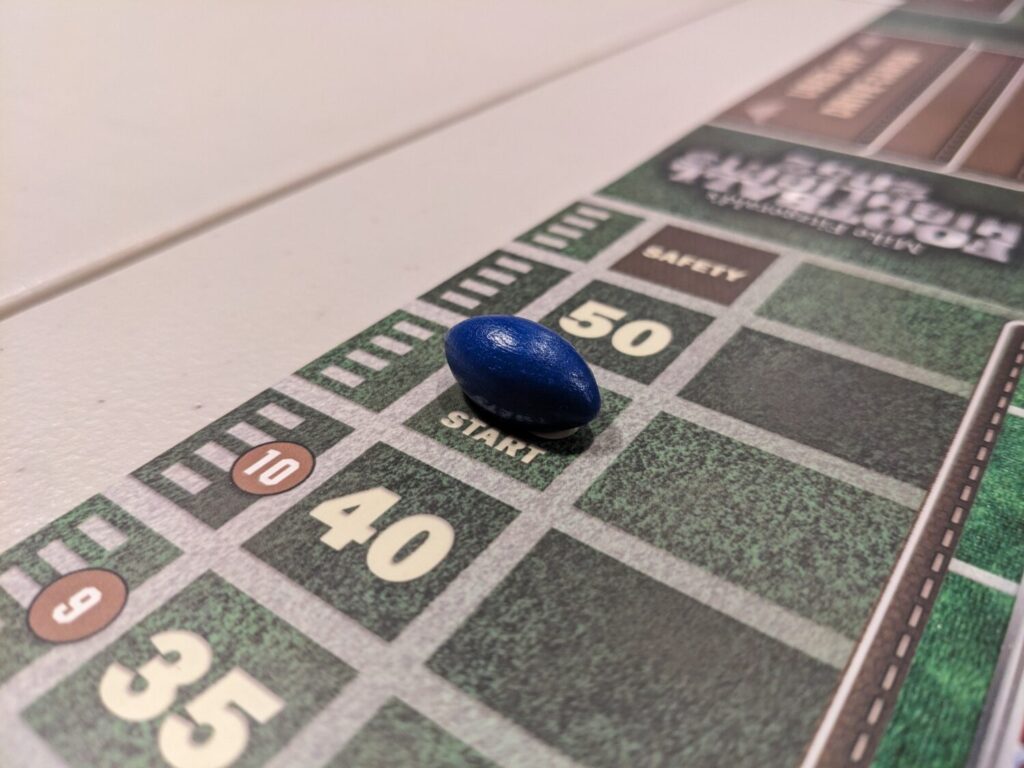
On a turn, a player will play a card that has a defensive alignment to react to the other player’s offensive play. Football Highlights: 2052 makes it very easy to determine how a play will turn out. If the offense runs a pass play, the defense must play a matching color card to stop the offense. Each play is also run into one zone of the field—left, center, and right, just like kickoffs in video games from Tecmo Bowl to Madden. If the defensive player can match both the type of play and the zone of play, the defense runs the text on their card, usually stopping the play outright.
If the defense doesn’t completely match the type of play or zone, then the offense gains a lot of yardage. The offense gets another bonus if the defense gets the type of play wrong, in the form of extra yards after a catch or the start of an offensive play. These can lead to big chunks of yardage and, hopefully, more touchdowns.
Then, the defensive player rotates their active card 180° to its offensive side, which has its own unique play type and zone of the field. Then the previous offensive player discards their old card, and plays a new one from hand to try and counter their opponent’s offensive play.
This means that a player has to choose both a defense AND their offense at the same time with a single card, which was a blast to try and plan out the right moves. That also made plays quick, and finding ways to allow the defense to bend but not break, to force field goals from time to time, ended up being the difference in each play. This goes back and forth until each player has run 10 plays, then a halftime session takes place where each player can add five new cards to their team and dump five cards, giving them a chance at some fresh plays for the second half.
Let’s talk about field goals for a moment…because scoring in Football Highlights: 2052 might become a make-or-break point in your experience.
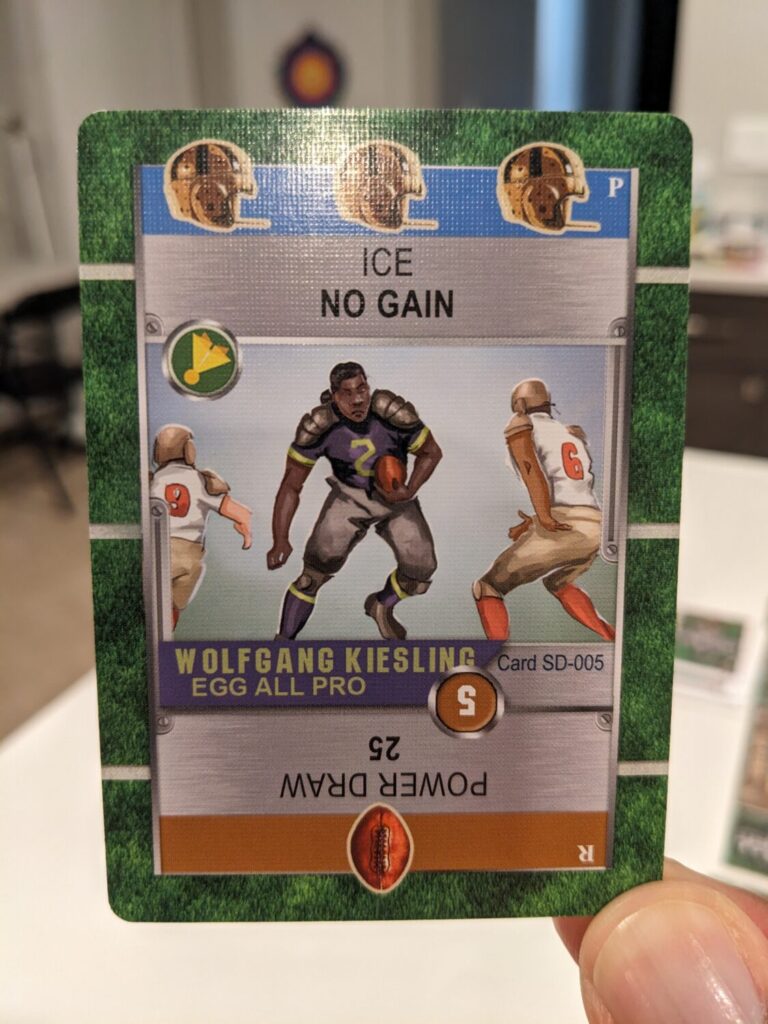
“The Final Score: Browns 9, Ravens 6”
Over the years, nothing has bored me more as a fan of the NFL quite like field goals. (Well, OK, I’m fine with watching field goals that may win or lose a game. But you know what I mean!) The current NFL has really nailed the level of competition and scoring; growing up, there were a lot more games that ended 10-7 or 12-6 than there are today, when offenses have finally figured out more ways to consistently score touchdowns.
In Football Highlights: 2052, I found that the team decks were so balanced that most of the initial turns in each half were…kind of dry. I would play a 30-yard pass to the right zone of the field, then the AI would play a card that perfectly countered my pass play. (And in solo play, the bot is just top-decking cards, so even when it was guessing, my offense would get stymied!) In head-to-head play, Joseph would play a 20-yard run play up the middle, and I had multiple cards that could stuff the run or maybe make the offense lose yardage.
My games of Football Highlights: 2052 usually featured low scores; I never scored more than 20 points in any of my three games. In the game against Joseph, I kicked four field goals and lost 14-12, thanks to a touchdown that he scored with his 20th and final card of the game. So, that game had drama and quite a few laughs, but it didn’t have much scoring.
Remember that Tecmo Bowl reference I made earlier? The designers of that game clearly understood what the people want…and the people want touchdowns. They don’t want multiple drives to end at the 20-yard-line, only to result in a field goal. (Kicking field goals in Football Highlights: 2052 is an easy process to administer, but it is not very dramatic, especially from close.)
While scoring is low and tight, the thing I appreciated most about Football Highlights: 2052 was the halftime player draft and the attention to detail given to the flavor text, like play calls or the names of the players. There are four team decks included: Dallas, Philly, New England and San Francisco. For fans of those NFL franchises, going through the cards and talking up Vernon Gore, Steve Clark, or Bryant Haley (each a first or last name of different players, like Steve Young and Dwight Clark) was a fun trip down memory lane.
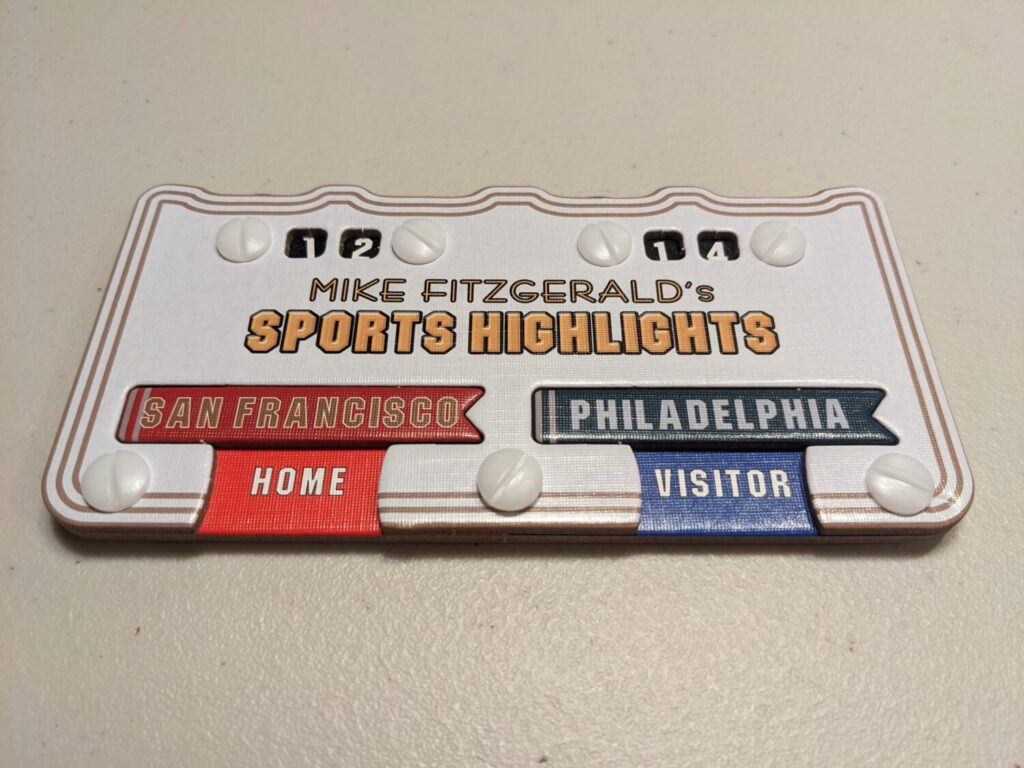
A #5 Seed, Not a #1 Seed
Football Highlights: 2052 does a good job of simulating a real football game, even if the depressed scores made me wish for more scoring opportunities. That’s because it gets every bit of the core elements behind running plays right thanks to an interesting card system. When the defense calls the proper formation to counter an offense, the defense gets rewarded. I just wish the defense was rewarded a little less often.
Another day, another great Eagle-Gryphon production, and the shining star here is the excellent player aid. Nearly every question we had was answered with the aid, so going back to the main rulebook was not needed more than once or twice (mainly to address injuries or other edge cases on action cards). The storage solution is clearly built for players who expect to buy additional team decks and promo cards, so there’s plenty of room for more content in the box.
The game runs right on the line of being too long; solo takes about 30 minutes, and my head-to-head game took about 50 minutes. Note that my times were shorter because I did not conduct a pre-game draft, so I think a draft would add at least 10 minutes to the playtime.
Solo play is very easy to administer, with a separate 25-card deck used to execute AI plays. It’s a nice teaching tool and I could see people using it as an activity while staring at Sunday afternoon NFL games each fall. I’m not ready to say that the AI is fair—it always felt like the AI had yet another 25-yard play up its sleeve that I couldn’t counter—but it is certainly easy to run.
Football Highlights: 2052 sits firmly in-between my two other experiences with the Highlights games. I really liked Baseball Highlights: 2045, while I thought that Basketball Highlights: Crunch Time left a lot to be desired. Give this one a look if you enjoy family-weight sports games!


